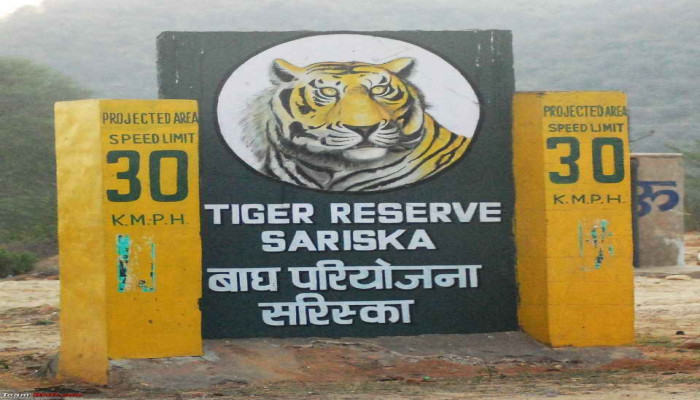SC halts all mining activities around Sariska Tiger Reserve
- In Reports
- 12:34 PM, May 16, 2024
- Myind Staff
The Supreme Court, led by Justices BR Gavai, Sandeep Mehta, and SVN Bhatti, has halted all mining operations surrounding Rajasthan's Sariska Tiger Reserve. In an order issued on Wednesday, May 15, the court restrained mining activities within a 1 km radius of the Critical Tiger Habitat (CTH).
The bench also instructed the Rajasthan government to develop a closure plan or undertake essential measures to adhere to its directives. The court has scheduled the matter for further hearing in July.
“We hold that any mining activity within 1 kilometre from a critical tiger habitat (CTH) will be violation of our April 26, 2023 order,” the bench also comprising justices SVN Bhatti and Sandeep Mehta said. “We direct Rajasthan to forthwith prohibit mining activities from one kilometre of CTH (tiger reserve) at Sariska.”
The Court was addressing an application moved in the TN Godavarman case pending before the forest bench since 1995. The application requested the State of Rajasthan to halt illegal mining activities within a 10 km area of the Sariska Wildlife Sanctuary without the approval of the National Board for Wildlife. Additionally, the application sought to stop mining within a 1 km area of the CTH, a protected zone of the Sariska Tiger Reserve.
The plea contended that numerous mining companies in Rajasthan were disregarding the orders and directives issued by the Supreme Court concerning mining operations in the Eco-Sensitive Zones, particularly in the Critical Tiger Habitat areas of the Sariska Tiger Reserve. It asserted that these companies operate without the necessary approvals from the National Board for Wildlife and Environmental Clearance.
The court was informed that 110 mines were operating within the area in violation of its April 26, 2023 decision that prohibited mining within one km from the boundaries of national parks and wildlife sanctuaries.
The Rajasthan government informed the court that the ban on mining, as mandated in April last year, was applicable to the eco-sensitive zone extending 1 km from national parks and wildlife sanctuaries, but it did not include tiger reserves.
Additional solicitor general (ASG) Aishwarya Bhati, appearing for Rajasthan, said the CTH serves as a buffer zone for the protection of Sariska Wildlife Sanctuary. She also pointed out that of the 110 mines, only 60 were operating within the 1-km radius.
The bench, however, said the stand taken by the state was “contrary” to law.
“Section 38XA of Wildlife Protection Act as interpreted by this court (in the recent judgment prohibiting tiger safari in Jim Corbett Park in Uttarakhand) will show that tiger reserve stands on a higher pedestal than wildlife sanctuaries and national parks,” the bench remarked.
“The interpretation by state is without reason. Our order of April 26, 2023 that prohibited mining activities within 1 km of protected area would not just mean sanctuaries and national parks, but CTH as well.”
The court found that some of the mines in Sariska were situated as close as 50 metres, 400 metres and 600 metres of the reserve’s boundary.
“Don’t do anything in the 1-km radius or if you wish to continue, then we will extend our order to 10-km radius, as fixed by our earlier order passed in June 2022,” the bench warned the Rajasthan government.
Advocate K Parameshwar, assisting the court as amicus curiae in forest matters, argued that the tiger habitat cannot be considered a buffer zone. He highlighted that Sariska was designated as a tiger reserve under Project Tiger in 1978.
In 2007, the Rajasthan government notified an 881.11 sq km area as the Critical Tiger Habitat (CTH), and through a subsequent notification in 2012, declared a 332 sq km area as the buffer zone of the Sariska tiger reserve. The advocate noted that out of the total CTH, 53.5 sq km is allocated for tourism purposes. He contended that allowing mining activity near this zone would be detrimental to the ecosystem of the tiger reserve.
Bhati informed the court that no mining is taking place within the CTR and the ones existing in the area around it were small mines. The court remarked, “Rajasthan is a state rich in minerals and the needs of people will never be fulfilled. If there are mines within 1 km, they must go.”
The judgment of April 2023, which also had justice Gavai, had modified the earlier order of June 3, 2022 and said, “We direct that mining within the national park and wildlife sanctuary and within an area of one kilometre from the boundary of such national park and wildlife sanctuary shall not be permissible.”
The Centre and several states had requested a modification of the June 2022 decision, which prohibited mining and other specified non-forest activities within 10 km of protected areas' boundary.
Image source: Wordpress







Comments